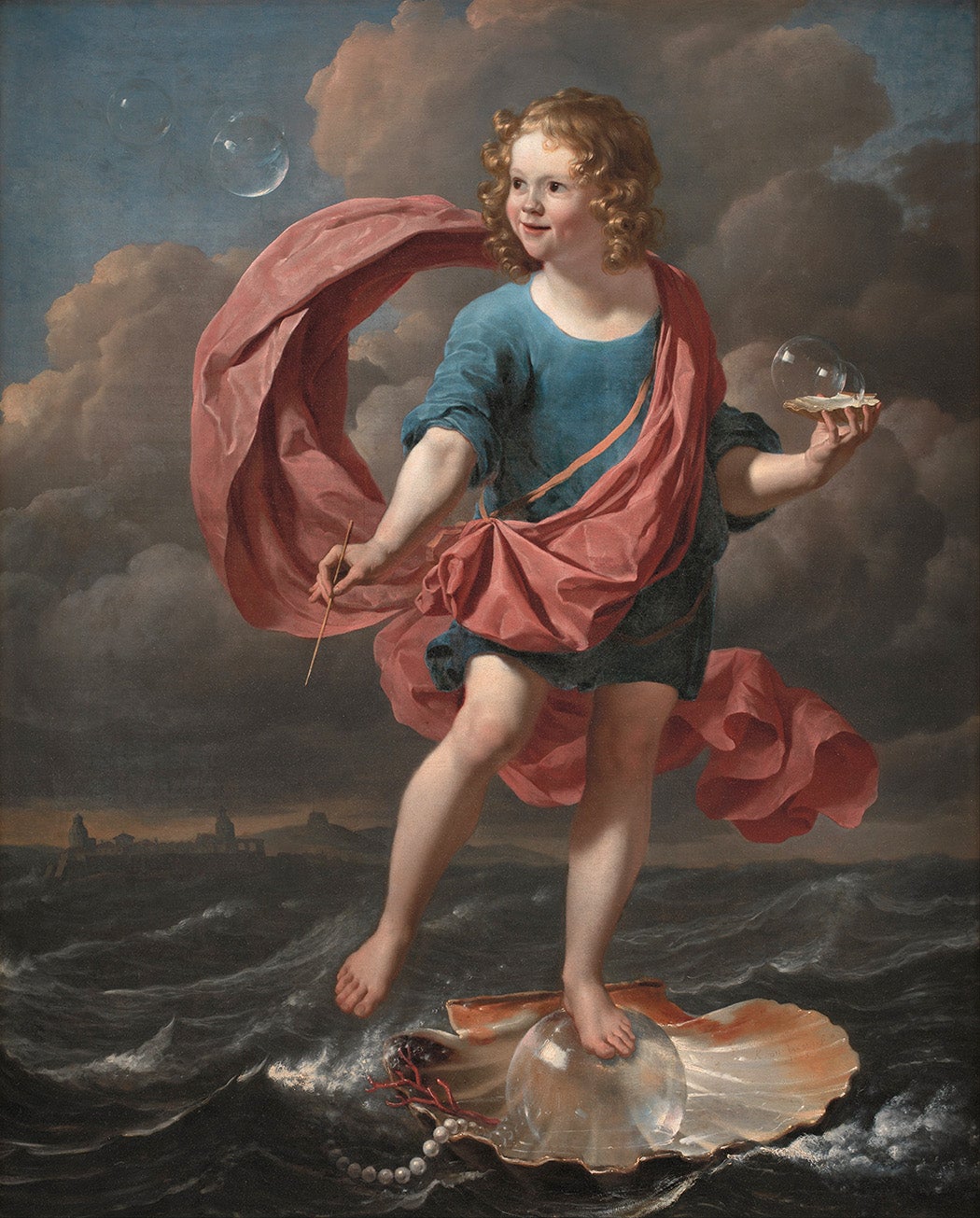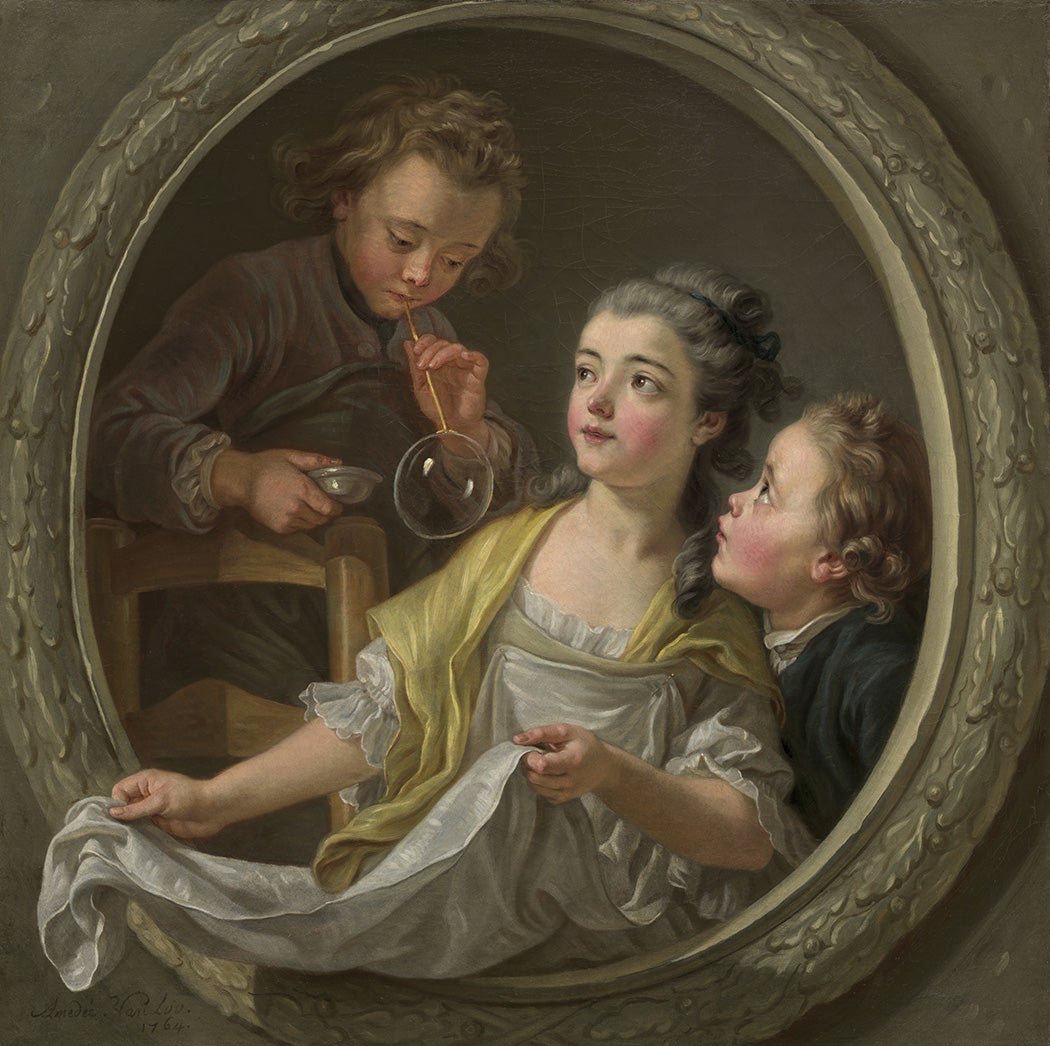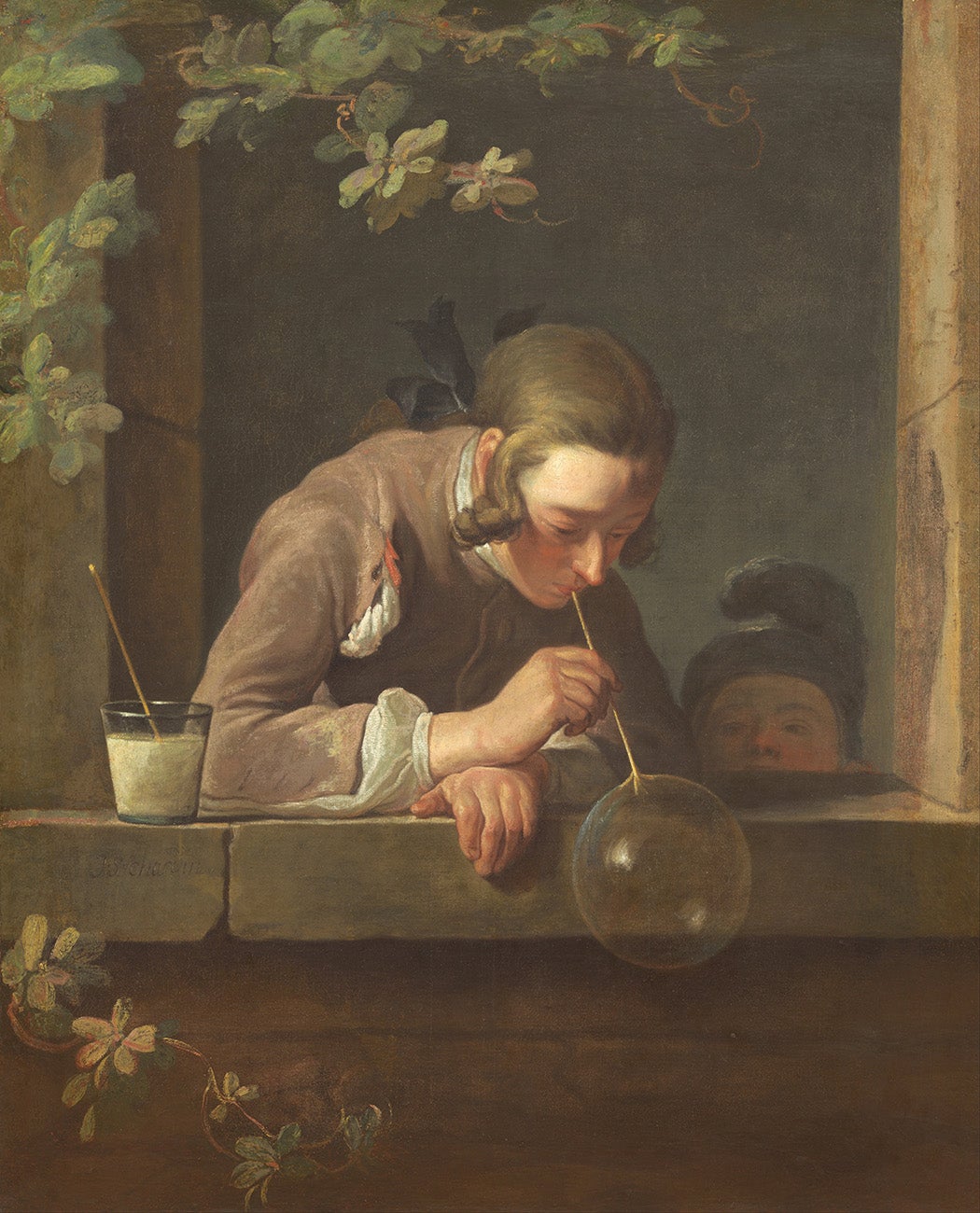What do the roof of the Munich Olympic Stadium, Glinda the Good Witch, Disney’s Cinderella, the art series “Unweave a Rainbow” by neo-surrealist painter Ariana Papademetropoulos, Sir Isaac Newton, the first “viral” ad campaign of the late Victorian era, and morose Dutch still-life paintings have in common? They all reflect a preoccupation with soap bubbles, with shiny, shimmery, and iridescent spheres that we tend to associate with children and play.
Far from being objects that just feed our natural proclivities toward shiny and shimmering surfaces, bubbles are a recurring trope in the history of philosophy, literature, the arts, and science. “Make a soap bubble and observe it; you could spend a whole life studying it,” Sir William Thomson, Lord Kelvin, allegedly said in the late nineteenth century.
Weekly Newsletter
Interest in bubbles in the arts, literature, and sciences reached a high point in the seventeenth century, when they became closely associated with the concept of vanitas vanitatum, the fragility and transience of human life. Homo bulla (man is a bubble) was a concept dear to the baroque era.
The symbolism of homo bulla was already proverbial by the first century BCE. Varro (116—27 BCE) wrote the following in the first line of the first book of De Re Rustica: “for if, as they say, man is a bubble (homo bulla), all the more so is an old man,” he wrote. In his Satyricon, Petronius (1st century CE) has a character bemoan the sudden death of a friend whose funeral he just attended by saying, “We are meaner than flies; flies have their virtues, we are nothing but bubbles.”
One of the most eminent early examples appears in a dialogue by second-century CE Greek-language writer Lucian of Samosata. In his Dialogue between Charon and Mercury, the former says:
I’d like to tell you, Mercury, that to me all men and their lives seem alike. Have you ever watched those bubbles that form in the pool of a waterfall? The foam which is made up of bubbles? The tiny ones break and vanish immediately…. That’s what man’s life is like.
When it comes to the visual arts, we have to credit Dutch artists for making bubbles a popular subject. In 1574, the Dutch painter Cornelis Ketel depicted a husky putto (cherub) standing against a cloudy sky on a bed of grass, in the act blowing bubbles. The inscription above, in Greek, reads “man is a bubble.” This panel is on the reverse of a portrait of Adam Wachendorff, the secretary of the London offices of the Hanseatic League, a trading alliance of European cities.
“It is likely that Ketel’s painting provides the first appearance of a soap bubble, as opposed to the more traditional air bubble on a water surface as in the Dialogue of Lucian,” writes the mathematician Michele Emmer in the journal Leonardo. (In 2019, Emmer curated a monographic exhibition on bubbles across the arts in Perugia, Italy.) In 1594, Hendrik Goltzius completed bubble- and putto-themed engravings that cemented the soap bubble as an enduring theme in Dutch art. In one titled “Homo Bulla,” a putto languidly leans on a skull as he absent-mindedly looks at the bubbles he just blew.

Throughout the seventeenth century, the putti started being “downgraded” to mere children. As the literary scholar Sarah Tindall Kareem wrote in her 2015 article “Enlightenment Bubbles, Romantic Worlds:”
The popularity of the subject of children blowing soap bubbles might be partly attributable to seventeenth century Dutch culture’s valorization of children’s play evident in the new genre of compendia of children’s games in which blowing bubbles is standard part of the repertoire.
The 1663 painting “Boy Blowing Soap Bubbles” by Karel Dujardin sees a boy looking with satisfaction at the bubbles he has just sent flying. He is balanced on a soap bubble resting on top of a shell, which is the only surrealist element of what would otherwise look like a realistic, if slightly mythologized, depiction of a youth entertaining himself.

Of course, not all depictions of bubbles feature children. In David Bailly’s “Vanitas: Self-portrait of the Artist, Still Life,” from 1651, floating bubbles appear alongside busts, candles, portraits, and skulls in a standard still-life setting. Similarly, Jan Steen’s “The Dancing Couple” (1663), leaves childhood imagery behind to depict a tavern scene where people are definitely having fun: musicians play, people dance, eat, and drink, while children play with their toys. The presence of cut flowers, broken shells, and soap bubbles are there to remind us of the transience of merriment and pleasure, but that does not necessarily have to mean doom and gloom.
“When, in overly moralized interpretations, we reduce such paintings to pictorial sermons on vanity, we fail to grasp…the ambiguous wholeness of these images,” writes the art historian Paul Barolsky. This wholeness “prompt[s] us to reflect not upon mortality alone, but upon the ways life and death define each other.”
Literary Bubbles
Between the sixteenth and seventeenth centuries, bubbles also became a popular subject in literature. In 1591, Francis Bacon asserted that “The world is a bubble.” In other words, a bubble is a microcosm of the world: each individual element bends toward fulfilling its purpose within the whole.
The seventeenth-century poet Richard Crashaw, who is best known for his religious poetry in English, also wrote erudite poems in Latin. One of them, “Bulla,” extensively describes a soap bubble in hallucinogenic detail: “There by the contiguous waters pale little torches droop. Here the vein of a very delicate wave full of the neighboring flames learns the purple paths and leaps from the red channel,” reads one translation. “Here is the intricate labor of heaven: orbs are in the path of orbs; here the herd of the golden fleece is the pellucid herd of the ether; which wear down the black pasture of night in pure bites.”

These passages record the ever-changing play of light and color on the surface of the bubble, while also acknowledging how hard it is to put into words. “The task Crashaw set himself in the poem is doomed to fail from the outset,” writes the Renaissance poetry scholar Stephen Guy-Bray in the Journal for Early Modern Cultural Studies. “But while ‘Bulla’ may not accurately describe a bubble, it could certainly be argued that it provides more information than a painting could: if we take ‘Bulla’ as an example of the popular Renaissance debate over the respective merits of painting and poetry we could argue that poetry wins.”
A bubble becomes a conceit that allows for the conceptualization of other things, of fictionality. As the literary scholar Kareem writes:
The bubble’s liminal status, materially between water and air, spatially between ground and sky, temporally between inflation and bursting, parallels fiction’s own boundary-crossing nature, making the bubble uniquely suited to metaphorically rendering the temporary transport fiction provides.
The Play of Light
Towards the end of the seventeenth century, scientists latched onto the subject of bubbles as well. “It is probably not insignificant that this same period saw soap bubbles achieve their greatest fame as a subject for painting,” Emmer (the mathematician) writes. “It is thus likely that children’s games and works of art stimulated scientists to try to understand the workings of these phenomena that were attractive and entertaining.”
In 1672, the English scientist Robert Hooke made this observation to the Royal Society in England:
A mass of bubbles was created in a soap solution by blowing into it through a glass tube. At the beginning of the experiment, one could easily see that the soap film enclosing each bubble of air was a clear white colour, without any trace of other colours. But after a while as the film gradually became thinner, one began to see all the colours of the rainbow on the surface of the bubbles.
In his Opticks: or, a treatise of the reflexions, refractions, inflexions and colours of light published in 1704, Sir Isaac Newton described the surfaces of bubbles in great detail. He argued that their colors are produced “on the same grounds that thin plates or bubbles do reflect or transmit those rays [of color].” Colors of bubbles, to him, were “a common observation” from which a theory could be built.

In 1827, the Bolognese painter Pelagio Palagi painted “Newton Discovers the Refraction of Light,” where Newton is depicted in being struck by the discovery of the phenomenon of light refraction as he observes a child blowing bubbles. In the painting, the bubble becomes the world, or at least its formal analog: just like a globe is placed on the right-hand side of Newton, the bubble occupies a similar position with the child. “Bubbles were to be to optics what apples had allegedly been to gravitation,” the historian of science Simon Schaffer once wrote.
An Enduring Fascination
In the following centuries, bubbles remained a subject dear to the arts. Jean-Baptiste Chardin’s “Les Bulles de Savon” (circa 1734) depicts two children who are playing at the moment when a bubble, already formed, is about to escape from the pipe. The search for complex moral or philosophical significance, beyond the evident allusion to the fragility of human life, is totally absent. The art historian Theodore Rousseau Jr. writes:
Judging from contemporary accounts, it appears unlikely that Chardin painted under the direct influence of any idea derived from classical or literary sources. His father, a carpenter, who is described as “distinguished by a talent for making good billiard tables,” was a poor man and unable to give him a formal education…
So, rather than focusing on the symbolism, Chardin concentrated on the technical aspects of his paintings.

Nineteenth century artists including Édouard Manet tended to shy away from the connotations of vanitas. The fourteenth canto of Byron’s “Don Juan” suggests how the bubble becomes a child’s plaything and a cosmic globe. Sarah Tindal Kareem writes that “[h]e moves away both from the bubble on a water surface as a symbol of vanitas and from connotations of puffery, embracing instead the soap-bubble as an emblem of verse’s sheer, ludic joy.”
On the other hand, John Keats famously accused Newton’s Opticks of “unweav[ing] a rainbow,” both at a dinner party hosted in December 1817 by Benjamin Haydon and in his poem “Lamia.” He claimed Newton “had destroyed all the poetry of the rainbow, by reducing it to prismatic colors,” according to Haydon’s own account. Nineteenth-century physicists and mathematicians, most notably the Belgian physicist Joseph Plateau, would devise a formula that could predict and explain the iridescent patterns of soapy films.
Yet they kept evoking a sense of wonder. “They are soap bubbles, pure chimerae that attract the imagination,” wrote Fyodor Dostoevsky in Crime and Punishment. In A Tramp Abroad, Mark Twain stated, “A soap-bubble is the most beautiful thing, and the most exquisite in nature… I wonder how much it would take to buy a soap-bubble if there was only one in the world.”
In the late nineteenth century, pre-Raphaelite painter John Everett Millais departed from the medieval settings of his earlier paintings, which featured sensuous maidens, to depict a boy blowing bubbles. Due to the fickle nature of bubbles, he had to resort to a glass globe to render their surface. It then became the official poster for Pears brand transparent soap, the first publicity campaign to use bubble (the first of many instances throughout the next two centuries). “Bubbles no longer symbolize ‘Vanitas,’” Emmer writes, “but rather the more down-to-earth qualities of freshness and cleanliness.”







